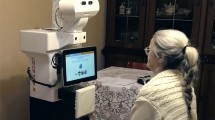Abstract
The purpose of this Wizard-of-Oz study was to explore the intuitive verbal and non-verbal goal-directed behavior of naïve participants in an intelligent robotics apartment. Participants had to complete seven mundane tasks, for instance, they were asked to turn on the light. Participants were explicitly instructed to consider nonstandard ways of completing the respective tasks. A multi-method approach revealed that most participants favored speech and interfaces like switches and screens to communicate with the intelligent robotics apartment. However, they required instructions to use the interfaces in order to perceive them as competent targets for human-machine interaction. Hence, first important steps were taken to investigate how to design an intelligent robotics apartment in a user-centered and user-friendly manner.
Access this chapter
Tax calculation will be finalised at checkout
Purchases are for personal use only
Similar content being viewed by others
References
Asimov, I.: AZ Quotes. http://www.azquotes.com/quote/877722
Kaasinen, E., Kymäläinen, T., Niemelä, M., Olsson, T., Kanerva, M., Ikonen, V.: A user-centric view of intelligent environments: user expectations, user experience and user role in building intelligent environments. Computers 2, 1–33 (2012)
Chan, M., Campo, E., Estève, D., Fourniols, J.Y.: Smart homes - current features and future perspectives. Maturitas 64, 90–97 (2009)
Pineau, J., Montemerlo, M., Pollack, M., Roy, N., Thrun, S.: Towards robotic assistants in nursing homes: challenges and results. Robot. Autonom. Syst. 42, 271–281 (2003)
Venkatesh, V., Davis, F.D.: A theoretical extension of the technology acceptance model: four longitudinal field studies. Manage. Sci. 46, 186–204 (2000)
Hong, X., Nugent, C., Mulvenna, M., McClean, S., Scotney, B., Devlin, S.: Evidential fusion of sensor data for activity recognition in smart homes. Pervasiv. Mobile Comput. 5, 236–252 (2009)
Chen, L., Nugent, C.D., Wang, H.: A knowledge-driven approach to activity recognition in smart homes. IEEE Trans. Knowle. Data Eng. 24(6), 961–974 (2012). IEEE Press, New York
Pavlou, P.A.: Consumer acceptance of electronic commerce: integrating trust and risk with the technology acceptance model. Int. J. Electron. Commun. 7, 101–134 (2003)
MeKa Robotics: Aaron Edsinger. Jeff Weger, San Francisco (2006)
Moore, R.K.: PRESENCE: A Human-Inspired Architecture for Speech-Based Human-Machine Interaction. IEEE Trans. Comput. 56, 1176–1188 (2007). IEEE Press, New York
Kelley, J.F.: An iterative design methodology for user-friendly natural language office information applications. T Inform. Syst. 2, 26–41 (1984)
Holthaus, P., Leichsenring, C., Bernotat, J., Richter, V., Pohling, M., Carlmeyer, B., Koster, N., zu Borgsen, S.M., Zorn, R., Schiffhauer, B., Engelmann, K.F., Lier, F., Schulz, S., Cimiano, P., Eyssel, F., Hermann, T., Kummert, F., Schlangen, D., Wachsmuth, S., Wagner, P., Wrede, B., Wrede, S.: How to address smart homes with a social robot? A multi-modal corpus of user interactions with an intelligent environment. In: 10th Edition of the Language Resources and Evaluation Conference, LREC Press, Portoroz (2016)
Max Planck Institute for Psycholinguistics: The Language Archive, Nijmegen, The Netherlands: ELAN. http://tla.mpi.nl/tools/tla-tools/elan/
Sloetjes, H., Wittenburg, P.: Annotation by category – ELAN and ISO DCR. In: Proceedings of the 6th International Conference on Language Resources and Evaluation, LREC Press, Marrakech (2008)
Holthaus, P., Pitsch, K., Wachsmuth, S.: How can i help? Int. J. Soc. Robot. 3, 383–393 (2011)
Acknowledgements
This research has been conducted in the framework of the European Project CODEFROR (FP7 PIRSES-2013-612555) and it was supported by the Cluster of Excellence Cognitive Interaction Technology ‘CITEC’ (EXC 277) at Bielefeld University, which is funded by the German Research Foundation (DFG).
Author information
Authors and Affiliations
Corresponding author
Editor information
Editors and Affiliations
Rights and permissions
Copyright information
© 2016 Springer International Publishing AG
About this paper
Cite this paper
Bernotat, J. et al. (2016). Welcome to the Future – How Naïve Users Intuitively Address an Intelligent Robotics Apartment. In: Agah, A., Cabibihan, JJ., Howard, A., Salichs, M., He, H. (eds) Social Robotics. ICSR 2016. Lecture Notes in Computer Science(), vol 9979. Springer, Cham. https://doi.org/10.1007/978-3-319-47437-3_96
Download citation
DOI: https://doi.org/10.1007/978-3-319-47437-3_96
Published:
Publisher Name: Springer, Cham
Print ISBN: 978-3-319-47436-6
Online ISBN: 978-3-319-47437-3
eBook Packages: Computer ScienceComputer Science (R0)




